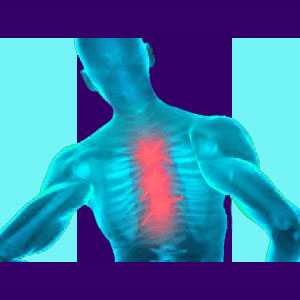
There are many possible causes of upper back pain, including back injury, age-related spinal degeneration, soft tissue pathology and other non-structural issues. Upper back pain is not nearly as common as lower back pain or neck pain and it often produces particular diagnostic challenges for this very reason. However, for patients who do suffer from thoracic dorsalgia, the symptoms can make life very difficult and can limit upper body functionality to a large degree. In order to recover from upper back pain, it is crucial to achieve a correct diagnosis and find suitable treatment for the causative condition.
This dialog explores the most common causes of upper back pain and discomfort, including muscular, spinal, systemic and mindbody sources. We will provide guidance for patients who are seeking information on the origin of their upper back pain and include links to additional resources that will be helpful in facilitating lasting relief based on accurate diagnosis, indicated treatment and a comprehensive recovery plan.
Structural Causes of Upper Back Pain
Spinal structural issues are the most commonly implicated sources of any type of upper back ache, despite being less prevalent in the upper thoracic spine than in other regions. Although degenerative disc disease and herniated discs are far less common in the upper thoracic region, they can still occur in some unfortunate patients, possibly enacting symptoms in rare cases. Likewise, upper thoracic spinal arthritis can also occur in a minority of people, potentially creating painful complaints through central or foraminal stenosis. It should be noted that most cases of arthritic change and disc degeneration are normal and not the source of any upper back pain symptoms. Only a tiny percentage of patients with these thoracic findings will indeed have pain which can be definitively traced to the structural issues.
Non-spinal structural concerns are also possible as sources of pain in the upper back. The most common of these include RSI, back strain and thoracic outlet syndrome. These diagnostic conclusions might be proven using MRI technology, but are usually ascertained through clinical experience, physical exam and expressed symptomology.
The least common causes of upper back pain due to structural issues include rare cases of hyperkyphosis, hypokyphosis, scoliosis and facet joint deterioration. While some of these processes are relatively commonplace, symptomatic versions are the gross exceptions to the rule.
Forward head posture is a common cause of chronic pain in between the shoulder blades.
Nonstructural Upper Back Pain Causes
Many cases of upper back discomfort are not caused by any spinal issue or other structural injury. This is particularly true for chronic upper back pain which seems to defy multiple seemingly appropriate treatment attempts. Remember, misdiagnosis is still a big problem for patients with upper back pain, just like it is for all chronic dorsalgia sufferers.
There are neuromuscular diseases that might create pain in some patients. There are also processes that might affect the upper dorsal internal organs and might be expressed as pain seeming to exist in the upper back.
A great number of affected patients with or without structural diagnoses are actually suffering from regional ischemia of the nerves and muscles in the upper back, possibly also including the brachial plexus. These oxygen deprivation back pain conditions are almost always linked to a psychosomatic source and will not generally respond well to tradtional medical treatment. However, knowledge therapy has proven itself to be an effectual alternative medicine choice for psychogenic ischemia wherever it occurs in the anatomy, including in the upper thoracic spinal region. The most recent statistics on back pain causation prove that the majority of patients have symptoms that can not be definitively traced to structural causes, making ischemia a more culpable villain than ever before.
Causes of Upper Back Pain Synopsis
The upper spine does not have to bend, flex and twist like the cervical or lumbar areas. This makes it far less susceptible to degenerative back pain conditions. The upper back is also not as susceptible to injury for these same reasons, but can be traumatized in such terrible circumstances as sports accidents, car accidents and serious falls.
Unless you have endured a major trauma which has been clearly proven to damage sensitive spinal structures in the thoracic spine, the chance of you suffering from structural back pain is rather low statistically. In cases where coincidental spinal scapegoat issues exist, you must be very careful, or else repeat the mistakes of so many before you: i.e. seeking treatment for a misdiagnosed condition. Make sure to research any diagnostic theory in great detail before acquiescing to therapy or especially surgery.
Remember that the human body is designed to be strong, resilient and fully capable of healing. It goes against our natural engineering to think that minor structural issues could possibly be responsible for the types of severe and persistent pain that are often blamed on them. Additionally, since many of these conditions include symptoms that do not correlate to the diagnostic theory proposed, the chances of structural-based diagnoses in the upper thoracic spine being valid are lower than ever before. Keep this in mind as you pursue diagnosis, treatment and recovery.




